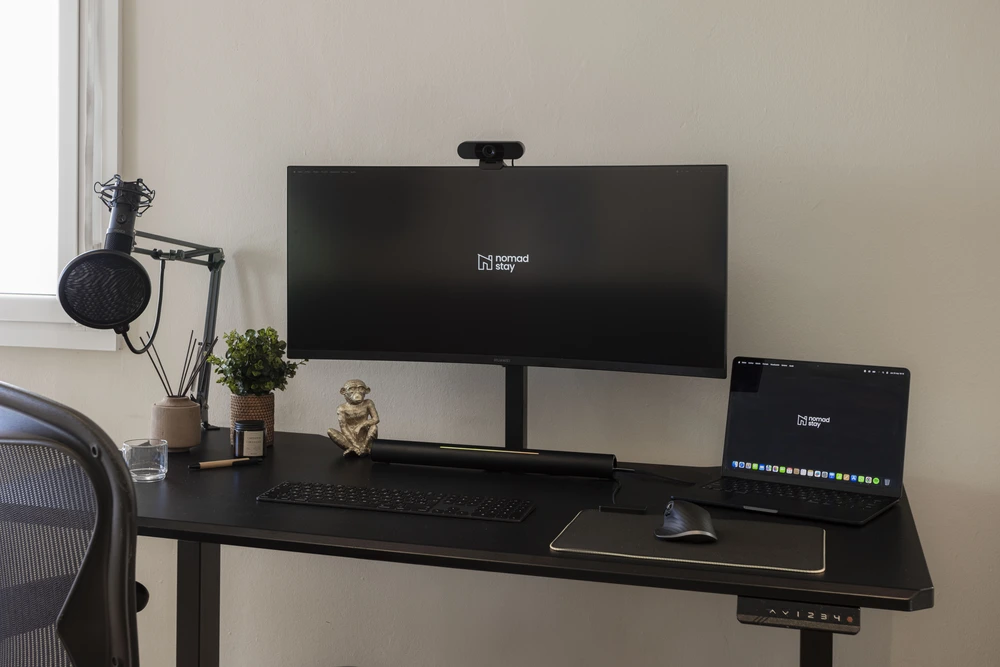Digital Nomad Income in 2025: How Much Are They Earning?
Explore the income landscape of digital nomads in 2025, revealing average earnings, gender gaps, and key factors influencing financial success.

- Digital Nomad Income in 2025: How Much Are They Earning?
- Digital Nomad Income Breakdown
- Factors Affecting Digital Nomad Earnings
- How to Pay Rent with Bitcoin & Crypto in 2025 | Complete Guide
- Ways to Increase Digital Nomad Income
- Financial Benefits of Being a Digital Nomad
- How to Make & Save Money as a Digital Nomad in 2025: Ultimate Guide
- Conclusion: Key Points on Digital Nomad Income in 2025
- FAQs
Digital Nomad Income in 2025: How Much Are They Earning?
In 2025, digital nomads earn an average of $123,762 annually, with most incomes falling between $50,000 and $250,000. Here's a quick breakdown:
- 69% earn $50,000-$250,000
- 35%: $100,000-$250,000
- 34%: $50,000-$100,000
- 21% earn under $50,000
- 9% make $250,000-$1,000,000
- 2% exceed $1,000,000
The concept of 'minimum income' is crucial for digital nomads, as it serves as a guideline for how much money is needed to sustain a lifestyle while traveling. This minimum income varies significantly based on the cost of living in different countries, with higher amounts required for areas with expensive living conditions compared to those in more affordable regions.
Gender Gap: Men earn $126,000 on average, while women earn $114,000, with disparities in high-paying tech roles. Employment Type: Full-time employees (39%) have stable incomes, while freelancers and startup founders (18% each) see more variability but higher growth potential. Top Fields: Software development, web development, and startup roles dominate high earners.
Factors like skills, specialization, and living location significantly impact income. High-demand technical roles, strategic salary negotiation, and cost-saving through location flexibility can boost earnings.
Introduction to Digital Nomads
Digital nomads are individuals who leverage technology to make an income while having the flexibility to travel to any desired location. The digital nomad lifestyle allows for location-independent work, enabling nomads to explore new cultures and experiences while maintaining a career. Many digital nomads work as remote workers, freelancers, or entrepreneurs, and can be found in various industries such as marketing, technology, and creative fields. To become a digital nomad, one must be willing to adapt to new environments and be self-motivated to manage their work remotely. With the rise of digital nomadism, many countries are now offering digital nomad visas, making it easier for individuals to work and live abroad.
Digital Nomad Income Breakdown
Income Brackets
In 2025, most digital nomads earn between $50,000 and $250,000 annually, with 35% falling into the $100,000-$250,000 range and 34% earning $50,000-$100,000. This shows that a large portion of digital nomads achieve financial stability, even with income variability. On the other end, 6% earn less than $25,000, 15% make $25,000-$50,000, and 11% surpass $250,000 annually. Among the top earners, 2% even hit seven-figure incomes. These figures highlight the wide range of earning potential, influenced by factors like expertise, experience, and industry demand.
Additionally, digital nomads' earnings can also be considered in terms of hourly rate. For example, Conversion Rate Optimization Specialists and SEO Specialists often have hourly rates ranging from $50 to $150, depending on their expertise and experience. This breakdown provides a clearer picture of the financial viability and flexibility associated with these roles.
Income by Gender
On average, men earn $126,000 annually, while women earn $114,000. Men also have a stronger presence in higher income brackets, with 36% earning $100,000-$250,000 compared to 30% of women, and 8% earning $250,000-$1 million versus 7% of women. Meanwhile, women are slightly more represented in lower brackets, with 8% earning under $25,000 compared to 6% of men. This highlights ongoing gender disparities in the digital nomad workforce, especially in more lucrative technical roles.
How much effort digital nomads put into their work can significantly influence their income. For instance, those who invest more time in crafting resumes and leveraging their expertise tend to see higher earnings. Additionally, individual budgeting and business ventures can cause income to vary significantly from month to month, showcasing the dynamic nature of a digital nomad's salary.
Income by Employment Type
The type of employment plays a big role in how much digital nomads earn. Full-time employees (39%), startup founders (18%), and freelancers (18%) make up the largest groups. Full-time employees and startup founders tend to dominate higher income brackets, while freelancers and part-time workers often face more income fluctuations, leading to lower earnings. Other segments include full-time contractors (9%) and agency workers (8%), with smaller numbers in part-time roles.
Self-employed digital nomads often experience significant income variability compared to other employment types, which can impact their financial stability and planning.
These income trends are shaped by factors like skill level, specialization, and location, which we'll dive into next.
Digital Nomad Jobs
Digital nomad jobs are career opportunities that can be performed remotely, allowing individuals to work from anywhere in the world. These jobs can range from programming and writing to graphic design and social media management. Digital nomads can find work as freelancers, remote employees, or entrepreneurs, and can use platforms such as Upwork or Freelancer to find clients worldwide. Some popular digital nomad jobs include web development, online teaching, and virtual assistance. With the advancement of technology, the number of digital nomad job opportunities is constantly growing, making it easier for individuals to adopt the digital nomad lifestyle.
Top Paying Digital Nomad Careers
Top paying digital nomad careers can vary depending on the industry and experience, but some of the highest paying jobs include software engineering, data science, and digital marketing. Digital nomads can earn a significant income by working as consultants, coaches, or online course creators. For example, a digital nomad working as a social media manager can earn an average monthly income of $3,000 to $5,000, while a software engineer can earn $6,000 to $10,000 per month. Other high-paying digital nomad careers include graphic design, SEO specialization, and web development. With the right skills and experience, digital nomads can earn a high income and enjoy the freedom and flexibility of working remotely.
Factors Affecting Digital Nomad Earnings
Skill Levels and Specialization
Earnings for digital nomads vary widely, and much of this comes down to skill level and specialization. High-paying technical roles, such as software development (34%) and web development (28%), tend to offer better salaries due to their complexity and strong market demand. However, these fields are often male-dominated, which plays a role in the income gap between male and female digital nomads.
Virtual assistants often perform a variety of tasks, including administrative duties, customer service, and data entry, which is a common task that supports employers remotely.
Here's a breakdown of some of the top high-paying, male-dominated careers:
| Career Field | Representation | Salary Advantage Over Other Gender |
|---|---|---|
| Software Development | 34% | +251% |
| Web Development | 28% | +264% |
| Startup Founders | 27% | +137% |
| Mobile Development | 11% | +349% |
On the other hand, nomads with more general skills or those working part-time typically earn less.
Location and Cost of Living
Where digital nomads choose to live and work has a big impact on their earnings. Living costs and market rates vary significantly between destinations. Many nomads split their time between high-cost hubs like the U.S. (14%), the UK (4%), and Germany (4%) and more affordable locations such as Thailand (5%), Mexico (4%), and Portugal (3%).
Digital nomad visa schemes in other countries, such as Greece, Malta, and Spain, offer different visa validity periods, requirements, and renewal options, providing a variety of choices for nomads.
One major advantage of the nomadic lifestyle is the ability to save on expenses. For instance, digital nomads save an average of $5,000 annually on commuting costs compared to traditional U.S. workers. Additionally, 42% of American digital nomads report earning $75,000 or more per year, partly due to leveraging cost-of-living differences[[1]](LINK 3).
These factors highlight how skillset and location can influence income potential, setting the stage for strategies to boost earnings.
Digital Nomad Visas
Digital nomad visas are special documents that allow remote workers to live and work in a country without being a tax resident. Many countries, including those in Southeast Asia, Central America, and the Caribbean, offer digital nomad visas, making it easier for individuals to work and live abroad. The requirements for digital nomad visas vary by country, but often include proof of income, health insurance, and a valid passport. Some popular countries for digital nomad visas include Malaysia, Thailand, and Costa Rica. Digital nomads can use these visas to work remotely and explore new cultures, while also taking advantage of the local cost of living and lifestyle.
Tax Implications for Digital Nomads
As a digital nomad, it's essential to understand the tax implications of working remotely. Digital nomads may be subject to taxes in their home country, as well as in the countries they visit. Some countries have tax exemptions for digital nomads, while others may require nomads to pay taxes on their worldwide income. It's crucial for digital nomads to research the tax laws and regulations of the countries they plan to visit and to consult with a tax professional to ensure they are meeting their tax obligations. Many digital nomads also take advantage of tax-advantaged strategies, such as offshore banking and income shielding, to minimize their tax liability. By understanding the tax implications of digital nomadism, individuals can make informed decisions about their finances and lifestyle.
Ways to Increase Digital Nomad Income
Skill Development and Specialization
Boosting your income as a digital nomad often begins with mastering sought-after skills. Fields like software development stand out, with web development (28%) and mobile development (11%) offering strong opportunities for those who excel in specific technologies.
To showcase your expertise and attract clients, it is crucial to create portfolios and businesses that highlight your skills and achievements.
For technical professionals, areas like software and mobile development tend to pay the most. Non-technical nomads can also increase their earnings by focusing on specialized niches such as technical writing or data analysis.
Here are some high-demand specializations:
| Specialization | Key Skills and Income Potential |
|---|---|
| Software Development | Full-stack development, Cloud architecture ($100k-$250k) |
| Mobile Development | iOS/Android, Cross-platform frameworks ($90k-$200k) |
| Technical Writing | API documentation, Technical communication ($75k-$150k) |
| Data Analysis | Python, SQL, Data visualization ($80k-$180k) |
Specializing in these areas not only increases your earning potential but also strengthens your position in salary discussions.
Salary Negotiation Tips
Once you've honed your skills, the next step is making sure you're paid what you're worth. Companies save on office-related expenses by hiring remote workers, and that cost-saving can work in your favor when negotiating.
Start connecting with other digital nomads to build a network and enhance your career opportunities.
Here's how to approach salary discussions effectively:
-
Research market rates: Check platforms like Glassdoor or remote job boards to understand salary trends for your role.
-
Highlight achievements: Keep a record of successful projects and positive client feedback to showcase your value.
-
Build a standout portfolio: Include examples of your specialized work that emphasize your expertise.
A notable stat: 42% of American digital nomads earn $75,000 or more annually [[1]](LINK 2). Use this as a benchmark to show how your skills align with market demands and deliver value to employers.
Financial Benefits of Being a Digital Nomad
Savings on Living and Commuting
Digital nomads often save a lot more compared to traditional office workers. Without the need for commuting or maintaining an office, they save an average of $5,000 annually in the U.S. [[1]](LINK 1). Plus, with 59% of digital nomads working from home offices, the expense of renting commercial spaces is completely avoided [[1]](LINK 2). The digital nomad lifestyle not only influences work settings but also impacts how individuals choose their essential gear, such as backpacks.
Location Flexibility and Lifestyle
One of the biggest perks of being a digital nomad is the freedom to choose where to live and work. This flexibility allows them to pick locations that maximize their income while keeping costs low. High earners might gravitate toward cities like London or New York, while others might opt for more affordable yet vibrant destinations like Lisbon or Bangkok[[1]](LINK 6).
Affordable, furnished housing options designed for remote workers also make it easier to balance cost and comfort. Financial perks of this lifestyle include:
-
Earning in strong currencies while living in countries with lower costs
-
Opportunities for tax savings (with proper professional advice)
-
Avoiding unnecessary lifestyle inflation
-
Access to global career options without being tied to one location
By cutting unnecessary expenses and choosing budget-friendly living arrangements, digital nomads can stretch their income further. This allows them to enjoy a high quality of life at a fraction of the cost faced by traditional office workers.
With careful planning, the digital nomad lifestyle offers a smart way to achieve financial stability and professional growth, even for those earning less. For digital nomads seeking to maximize their efficiency, exploring productivity tips can be beneficial.
How to Make & Save Money as a Digital Nomad in 2025: Ultimate Guide
Conclusion: Key Points on Digital Nomad Income in 2025
By 2025, the digital nomad lifestyle showcases the expansion and variety of remote work, with most professionals earning between $50,000 and $250,000 annually. This shift highlights how digital nomadism has become a professional and financially stable career option, far removed from its earlier stereotypes.
The earnings concentrated in middle to upper-middle income brackets reflect the maturity of remote work opportunities. Digital nomads engage in various work setups, including full-time roles, freelancing, and startups - each offering different paths to financial success and career development.
Remote work offers clear financial perks. With lower commuting and workspace expenses, digital nomads often enjoy more disposable income. Coupled with thoughtful choices about where to live, many are able to maintain a high standard of living while building financial security.
Strategic decisions about location and work arrangements play a big role in maximizing income potential. Specialized skills, especially in tech and creative fields, are increasingly valuable for thriving in this lifestyle. Combining these skills with smart planning allows digital nomads to achieve both financial goals and a flexible, fulfilling lifestyle.
These trends highlight the growing appeal of digital nomadism as a realistic and rewarding career path. The data supports its viability across different industries, driven by the acceptance of remote work and the demand for specialized expertise [1].
FAQs
How much money can you make as a digital nomad?
Earnings for digital nomads in 2025 vary greatly, with an average annual income of $123,762. The majority (69%) fall between $50,000 and $250,000 per year. Breaking it down further, 35% earn between $100,000 and $250,000, while 34% are in the $50,000-$100,000 range. Digital nomad salaries often spark curiosity, with many wondering about the financial realities and myths associated with this lifestyle. It's important to consider the income potential and necessary financial planning for sustaining a nomadic lifestyle while traveling.
Top Earners: A small percentage of digital nomads reach higher income tiers: 9% make between $250,000 and $1 million, and 2% earn over $1 million annually. High-paying fields like software development and crypto often drive these earnings, with full-time employees and startup founders leading these categories.
Making the Most of Your Income: Choosing affordable locations while earning in strong currencies is a smart way to stretch your income. Cities like Lisbon and Chiang Mai are popular choices for maximizing purchasing power, regardless of your income level.
Employment Type and Gender Gap: Full-time employees tend to dominate the higher income brackets, while freelancers often experience more income fluctuations. A gender gap also exists, with men earning an average of $126,000 compared to $114,000 for women, particularly in tech-related fields.
Related Articles

Digital Nomad Tax Guide: What You Need to Know
Understanding your tax obligations is essential for digital nomads to avoid legal issues and optimize finances.

Top 10 Most Affordable Cities for Digital Nomads in 2025
Discover which global cities offer the best balance of cost of living, amenities, and community for remote workers.

10 Most In-Demand Skills for Digital Nomads in 2025
Learn which skills command the highest rates in the remote job market and how to develop them.
























